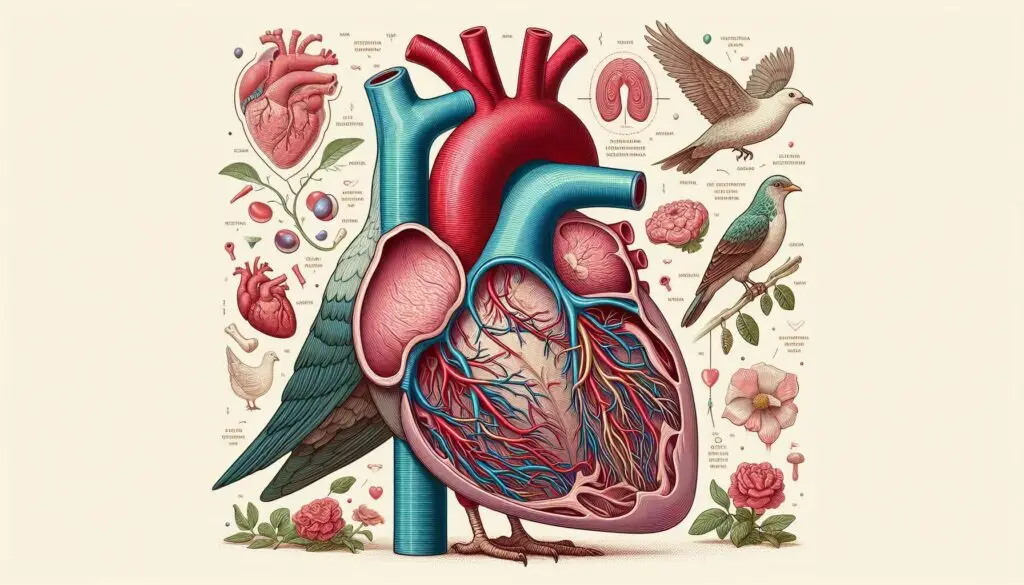Understanding the Cardiac Cycle in Birds

Structure of the Avian Heart
Birds have a four-chambered heart, which includes two atria and two ventricles. This design is similar to that of mammals but features some key differences that enhance its efficiency.
Size and Functionality
Birds generally have larger hearts relative to their body size compared to mammals. This larger size is essential for meeting the high energy demands during flight. Interestingly, smaller bird species often have proportionally larger hearts than larger species. For example, hummingbirds possess the largest hearts relative to their body mass due to their energy-intensive hovering flight.
Chambers and Valves
The heart consists of:
- Right Atrium: Receives deoxygenated blood from the body.
- Right Ventricle: Pumps deoxygenated blood to the lungs.
- Left Atrium: Receives oxygenated blood from the lungs.
- Left Ventricle: Pumps oxygenated blood to the rest of the body.
The atrioventricular (AV) valves in birds differ from those in mammals. The left AV valve has three cusps, while the right AV valve is a single flap of myocardium. This unique structure aids in efficient blood flow through the heart.
Phases of the Cardiac Cycle
The cardiac cycle consists of several phases that ensure effective blood circulation throughout a bird’s body. These phases include:
- Diastole: All chambers relax, allowing blood to flow into the atria and ventricles.
- Atrial Systole: The atria contract, pushing additional blood into the ventricles.
- Ventricular Systole: The ventricles contract, closing the AV valves and opening the semilunar valves to pump blood into the pulmonary artery and aorta.
- Return to Diastole: The heart relaxes again, preparing for another cycle.
This rhythmic contraction and relaxation optimize blood flow and oxygen delivery.
Unique Features of Avian Cardiac Physiology
Birds exhibit several unique physiological traits that enhance their cardiac function:
Higher Cardiac Output
Birds achieve a higher cardiac output than mammals due to their ability to increase heart rate significantly during activity. For example, during flight, a bird’s heart rate can soar much higher than when at rest.
Coronary Circulation
In birds, perfusion of heart muscle occurs primarily during diastole. This contrasts with mammals where perfusion can happen during both systole and diastole. This adaptation allows birds to meet high oxygen demands while flying at various altitudes.
Electrical Conduction System
The avian heart has a specialized conduction system that ensures rapid contraction rates necessary for flight. This system includes structures similar to those found in mammalian hearts but adapted for avian needs.
Adaptations for Flight
Birds have evolved several adaptations in their cardiovascular systems to support flight:
High Blood Pressure
Birds maintain higher arterial blood pressure compared to mammals of similar size. This adaptation allows for efficient oxygen delivery even under strenuous conditions.
Efficient Oxygen Utilization
Birds have developed mechanisms that enhance oxygen diffusion from blood into muscle tissues. For instance, species like bar-headed geese possess more capillaries per muscle fiber than many other birds, improving oxygen transport during high-altitude flights.
Temperature Regulation
As homeotherms, birds must regulate their internal body temperature while flying. Their cardiovascular system plays a crucial role in maintaining this balance by adjusting blood flow as needed.
Conclusion
The cardiac cycle in birds showcases remarkable adaptations that enable these creatures to thrive in various environments while meeting their high metabolic demands for flight. Their unique heart structure and efficient physiological processes highlight how evolution has shaped avian biology for optimal performance.
By understanding these intricate details of avian cardiovascular systems, we gain insight into how birds manage energy efficiently while engaging in activities like flying at high altitudes or enduring extreme temperatures.
For more pearls of Vets Wisdom:
https://wiseias.com/partitioning-of-food-energy-within-animals/






Responses